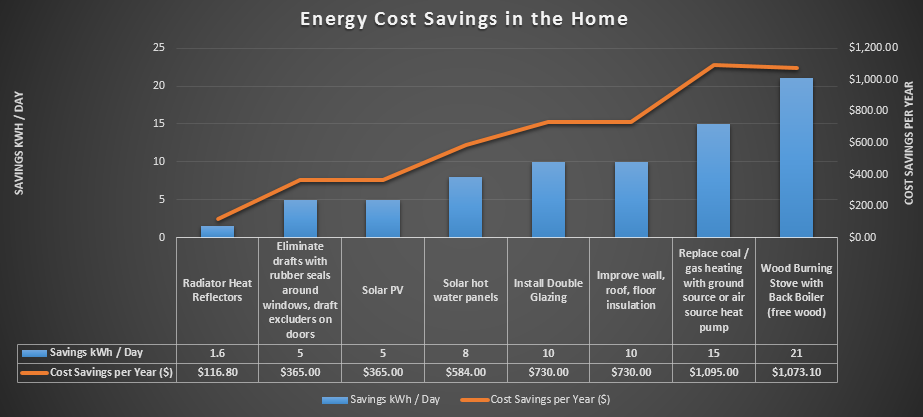The energy consumption (e.g. cost) when Heating a Building (or cooling one) is pretty simple to calculate. It’s defined by the Average temperature difference with the outside multiplied the leakiness of the building. If the energy source isn’t renewable, then that’s decided by the efficiency of the heating source.
I live in a cooler country, so all costs in this regard are to heat the building, but the same thing applies to cooling with air conditioning. The hotter it is outside, and the cooler the house, the more energy it takes to keep the inside temperature consistent.
That means there are three things you can do, and in this order:
- Reduce the temperature difference with the outside: one or two degrees makes a big difference.
- Reduce the leakiness of your building: Install double glazed windows, put rubber seals around the doors.
- Add heat to the building: wood burning stove, hot water solar
Lowering Energy Costs should start with Efficiency measures:
- Lowering the thermostat to decrease the temperature difference with the outside
- Installing Radiator Heat reflectors to direct all heat into the building rather than out through the walls
- Installing better insulation in the attic to stop heat floating up and out of the house
- Installing double or triple glazed windows to cut down on the amount of heat escaping
After these are implemented, and the consumption is as low as it can go, then it’s time to start thinking about making that generation as cheap and efficient as possible. Some options are:
- Hot water Solar
- Ground and Air Source Heat Pumps
- Wood Burning Stove with a back boiler
The payback calculations can inform which of these to go after first to reap the biggest savings over time. A heat pump comes out top in terms of payback. An air source heat pump will cost (very roughly) $8000, and save $730 a year, giving a payback of about 11 years. It displaces a very large amount of heating though, so once the payback period is over, the 25 year saving comes to 25 * 730 = 18,250 – 8000 = $10,250 which is a serious saving.
A wood burning stove with a back boiler is another good option if you have access to cheap or free wood to burn. It essentially replaces gas or oil as the heat-fuel source and once installed, will cost very little to run. This is the option which I have gone for (see a future post with the granular breakdown). It cost €4000 to install, and it’s saving €828.88 per year, averting a whopping 13,813 kWh of gas and 3,177 kgCO2 per year. The payback on it is 4.83 years and the 25 year saving is €16,722 (€828.88 * 25 = €20,722.00 – €4000 = €16,722). I’m happily spending that €16,722 on something other than my gas bill!
Bringing these together into one gives us:
What does all this tell us? In summary:
- Start by turning down the thermostat in colder countries, and turning down the A.C. in water countries
- Next, install insulation in the attic, insulate the walls, install double/triple glazed windows and add radiator heat reflectors
- Finally, replace expensive oil / gas boilers with a wood burning stove + back boiler (if you have access to cheap, sustainable wood) or with Hot water Solar or an air source heat pump.
With these measures complete, you’ll avoid pumping massive quantities of inefficiently generated heat out into the air, and save a huge amount of money in the process.
References:
[1]: “It’s defined by the Average temperature difference with the outside multiplied the leakiness of the building”: Sustainable Energy Without the Hot Air, Page 140
